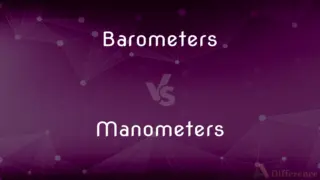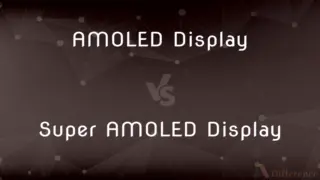Screen Protector vs. Tempered Glass — What's the Difference?
By Tayyaba Rehman — Published on January 28, 2024
A screen protector is a thin film applied to screens for scratch protection, while tempered glass is a thicker, more durable protector offering impact resistance.

Difference Between Screen Protector and Tempered Glass
Table of Contents
ADVERTISEMENT
Key Differences
A screen protector is typically a thin, plastic film or a polyurethane material that adheres to the screen of a device to guard against scratches and minor abrasions. Tempered glass, on the other hand, is a type of safety glass processed by controlled thermal treatments to increase its strength, providing superior protection against impacts and deep scratches.
The installation process of a screen protector usually involves carefully aligning the film and smoothing out any air bubbles. In contrast, tempered glass protectors are more rigid and are applied using a silicone adhesive, which makes them easier to align and less prone to air bubbles.
Screen protectors offer a virtually invisible layer of protection and usually don't affect the touch sensitivity or clarity of the display. Tempered glass protectors are thicker, offering more noticeable protection, and can sometimes slightly affect the feel and responsiveness of the screen.
In terms of durability, a screen protector may need to be replaced more frequently due to wear or peeling. Tempered glass, being more robust, generally lasts longer but may shatter upon strong impact, necessitating replacement.
Price-wise, basic screen protectors are generally cheaper than tempered glass options. However, the latter offers better value in terms of the level of protection and longevity it provides for the device's screen.
ADVERTISEMENT
Comparison Chart
Material
Plastic film or polyurethane
Safety glass
Protection Level
Against scratches and minor abrasions
Against impacts and deep scratches
Installation
Prone to air bubbles, requires precision
Easier, less prone to air bubbles
Durability
Less durable, frequent replacement
More durable, longer-lasting
Impact on Touch Sensitivity
Minimal effect
Slight effect possible
Compare with Definitions
Screen Protector
A thin film applied to a device’s screen for scratch protection.
I always use a screen protector to keep my phone's display scratch-free.
Tempered Glass
A screen protector providing enhanced tactile experience.
The tempered glass maintains the smooth touch response of my device's screen.
Screen Protector
A barrier against dirt, smudges, and minor abrasions.
The screen protector helps keep my tablet's screen clean and unblemished.
Tempered Glass
A type of safety glass used for superior screen protection.
I dropped my phone, but the tempered glass saved the actual screen from damage.
Screen Protector
A protective layer that guards against daily wear and tear.
Installing a screen protector is an easy way to extend the life of your smartphone.
Tempered Glass
A robust screen protector offering impact resistance.
The tempered glass can absorb shock, protecting the screen from cracks.
Screen Protector
A transparent overlay that maintains screen clarity.
The screen protector is so clear, you can't even tell it's there.
Tempered Glass
A glass protector that shatters upon hard impact to protect the screen.
When the tempered glass shattered, it absorbed the impact, sparing my phone's screen.
Screen Protector
A removable and replaceable protective accessory for screens.
Once the screen protector gets scratched, I simply replace it with a new one.
Tempered Glass
A thicker, more durable alternative to plastic screen protectors.
Tempered glass feels more like the original screen than a plastic protector.
Common Curiosities
Can tempered glass protectors shatter?
Yes, they can shatter upon strong impact, absorbing the shock to protect the screen.
How does tempered glass offer better protection?
It’s thicker and stronger, providing better resistance to impacts and deep scratches.
Do screen protectors affect screen clarity?
High-quality protectors maintain screen clarity, though poor-quality ones might not.
Is tempered glass more expensive than a regular screen protector?
Generally, yes, due to its greater durability and protection level.
Are screen protectors easy to apply?
Yes, but they require careful alignment and smoothing out of air bubbles.
Do I need a professional to apply a tempered glass protector?
Not necessarily, as many come with kits that make self-application easy.
Can a screen protector completely prevent screen damage?
They greatly reduce the risk, but no protector can guarantee complete prevention.
What is the primary function of a screen protector?
To protect a device’s screen from scratches and minor wear.
How often should I replace my screen protector?
Replace it if it gets scratched, peels, or loses adhesion.
Does tempered glass feel different than a screen protector?
Yes, it feels more like the original screen and can offer a better touch experience.
Are there different types of screen protectors?
Yes, including clear, matte, privacy, and anti-glare varieties.
Should I use a screen protector if I already have tempered glass?
No, using both is unnecessary as tempered glass offers ample protection.
Can I remove and reuse a tempered glass protector?
Removal is possible, but reusing it might not provide the same adhesion and protection.
Do tempered glass protectors come in different thicknesses?
Yes, varying from ultra-thin to slightly thicker options for extra protection.
Are screen protectors compatible with all cases?
Most are, but it’s best to check compatibility, especially with edge-to-edge protectors.
Share Your Discovery

Previous Comparison
Barometers vs. Manometers
Next Comparison
AMOLED Display vs. Super AMOLED DisplayAuthor Spotlight
Written by
Tayyaba RehmanTayyaba Rehman is a distinguished writer, currently serving as a primary contributor to askdifference.com. As a researcher in semantics and etymology, Tayyaba's passion for the complexity of languages and their distinctions has found a perfect home on the platform. Tayyaba delves into the intricacies of language, distinguishing between commonly confused words and phrases, thereby providing clarity for readers worldwide.














































